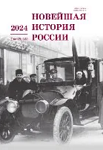Празднование Пасхи: тревоги советского государства (середина 1940-х - середина 1980-х годов)
Easter Celebration: Troubles of the Soviet State (mid 1940s - mid 1980s)
Author(s): A.V. GorbatovSubject(s): Christian Theology and Religion, Jewish studies, WW II and following years (1940 - 1949), Post-War period (1950 - 1989), Eastern Orthodoxy, Other Christian Denominations, Sociology of Religion
Published by: Издательство Исторического факультета СПбГУ
Keywords: USSR; Easter; holiday; state-confessional relations; Western Siberia; Orthodox; Protestant; Jewish; communities;
Summary/Abstract: The research is based on documents from the State Archives of the Russian Federation, materials from six archives of Western Siberia (Kemerovo, Novosibirsk, Tomsk, and Omsk regions), as well as on research works by Russian historians. The author identifies and characterizes the most important specific aspects of the celebration of Easter, which caused concern among state bodies, including church attendance, the content of the sermon, public reaction, the age and gender composition of those participating in the event, the presence of children and youth at the Easter service, the amount spent on the celebration and income from the sale of candles, the consecration of Easter cakes, and public safety. It was found that according to the indicated parameters, the authorities supervising religious organizations tried to determine the level of life and religiosity of a particular denomination. A differentiated approach in religious policy towards different Christian denominations is noted, which is associated with the degree of loyalty of a religious organization to the Soviet state and legislation on cults. Leaders and activists of unregistered associations, such as the Council of Churches of Evangelical Christian Baptists, openly violating Soviet law, including on Easter days, were subject to administrative measures and criminal prosecution. The holding of the Jewish celebration of the “Jewish Passover” — Pesach, along with Easter among Christian denominations, was also within the scope of the general control of state bodies. As religious policy softened, measures to limit religiosity weakened, control and pressure decreased, with the exception of marginal religious associations that chose confrontation with the authorities. The tradition of celebrating Easter during the period under study remained stable, passed through the entire Soviet period and lasted until the beginning of perestroika — another period of changes in state confessional policies.
Journal: Новейшая история России
- Issue Year: 14/2024
- Issue No: 48
- Page Range: 736-750
- Page Count: 15
- Language: Russian

